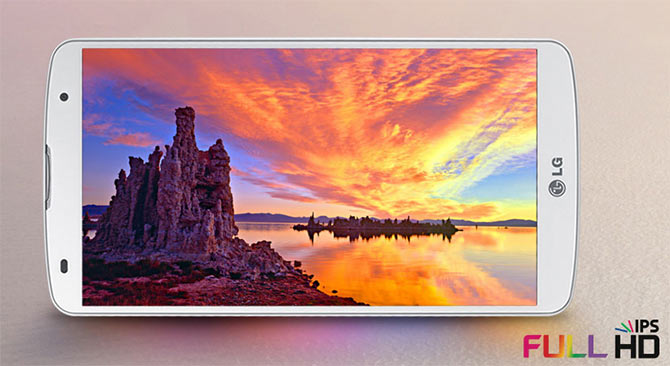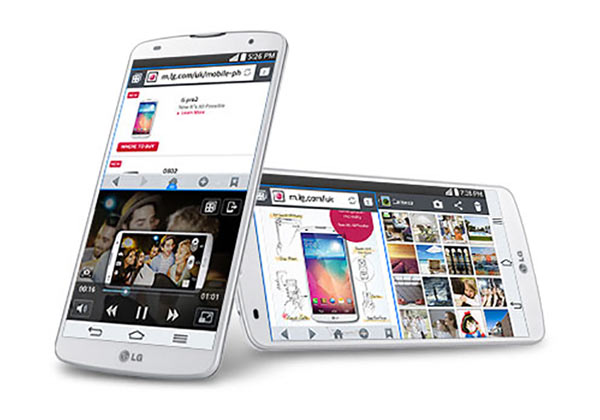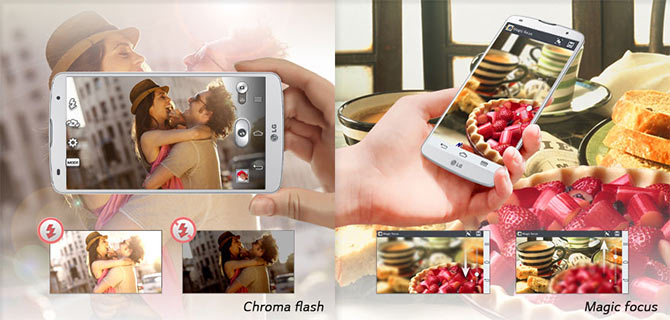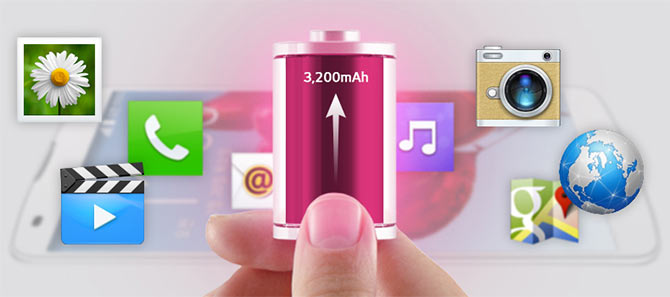Photographs: lg.com Himanshu Juneja
With the launch of LG G Pro 2, LG brings forward a serious contender in the world of phablets. With a brilliant screen, a very capable camera, and the power to churn out delectable graphics, LG has laid claim to be among the top 3 competitors.
How much can a phone with 4k recording and impressive battery lay its claim against a top competitor? We take an up and close look at the impressive phone from LG.
Specs:
- OS: Android ver 4.4.2 (KitKat)
- Display: 5.9 inches @ 1080 x 1920 pixels (~373 ppi)
- Processor: 2.26 GHz Quad-core Krait 400
- RAM: 3 GB RAM
- Camera: Primary: 13 MP with LED flash (optical image stabilisation); Secondary: 2.1 MP
- Memory: 16/32 GB
- Battery: Li-Ion 3200 mAh battery (Removable)
Please click NEXT to continue reading
Design and built
Photographs: lg.com
One look and the obvious thought which comes to the mind is that this phone is quite a handful. In fact, people with small or even regular hands should be prepared to be using it with a lot of care.
The mesh like design given on the rear panel does provide a good grip, but the feel isn't premium. The material used for the built is plastic.
Another interesting thing to note is that one struggles to find any buttons immediately. The reason being that LG decided to move them to the rear panel.
The volume rocker has been placed on the rear panel, making the edges of the phone free from any buttons at all. To be more precise, the camera module is on top, followed by volume up button, the power button, and finally the volume down button.
The power button doubles up as an LED notification light for those important notifications.
This really can be a hit and miss for people while they try to located the button which are not visible.
The bottom edge of the phone houses the microphone and the MicroUSB port. The Infra Red LED, 3.5 mm Audio jack and another microphone have been placed on the top edge.
The microSD card slot has been placed above the SIM card slot, and an educated guess says that the placement of the former might not encourage people for frequent replacements.
Upon opening the rear panel, one finds that the speaker has been placed below the battery.
Please click NEXT to continue reading
Display
Photographs: lg.com
The phone's display is one of its biggest strengths. The 5.9-inch screen, carrying a resolution of 1080x1920 is stunningly beautiful.
Watching the videos or playing games becomes a delightful experience. The pixel density of the screen being ~373 provides ample assurance that the display won't be disappointing in terms of details.
The screen has pretty good viewing angles, add to that, the visibility outdoors is pretty good as well.
Despite the size, the display doesn't lend too much of the bulk to the overall weight, and that really is a commendable job.
The IPS LCD display unit on this device shines with its performance.
Please click NEXT to continue reading
OS and features
Photographs: lg.com
Being powered by Snapdragon 800 quad core, and with 3GB RAM, the phone performs smoothly. The phone never showed any signs of lag or stuttering even while playing CPU intensive games.
The phone performs as per expectations. The phone got a little warm only after some sustained session of gaming.
The phone comes with Android 4.4.2 Kitkat preloaded and contains the usual Google apps, but LG also has tried to bring some of its unique apps and features together which were rather impressive.
Mini View
A special mention definitely goes to the Mini View. This basically shrinks the display on the giant screen to be more manageable for one hand usage only. Users who travel a lot via public transport like metro or trains in general will find this a blessing.
To activate it, one has to simply swipe the on screen buttons, and the display will be reduced to a mini version. A simple tap will restore the view to regular mode.
Knock Code
The Knock On function, where the user wakes up the phone by tapping on the screen twice, has been enhanced a little bit more on the G Pro 2.
The Knock Code combines the action of waking up the screen and unlocking the phone in a single step. The display shows four quadrants, and the user can set a combination by tapping on these four sections in the desired way.
As the range of combinations here is from two to eight taps, the total possibility is 80,000 unique combinations. This provides high level of security to the device.
Although the feature works generally, the trick here is that one has to be very distinct with the taps, else the attempts will not be successful.
LG should upgrade the ease of use with the next update push.
Q Slide
This feature is native to the LG Phones. It allows the apps to be moved around the screen as per the convenience, and minimised or maximised by a mere single tap.
This should come in handy and with a big screen, just might see more frequent usage.
Infra Red LED
The IR sitting on top of the phone has a nice usage of its own, that is to start using it as a remote.
The Quickremote feature makes itself useful by allowing compatibility with devices like the television, air conditioner etc.
Content Lock
As the name suggests, the user gets to password protect selected files and restrict their access.
This is a welcome feature and should make many users happy.
Guest Mode
This feature has readily found favour with smartphone manufacturers of late. As the name would suggest, this feature locks down few of the apps, allowing only the selected few to be used.
This mode can especially come in handy while giving your phone to kids.
Slide Aside
This allows the user to swipe away an app by carrying out the action using three fingers. Basically an app switching feature. This is a useful one here, and may come in handy for people who like to flip between a lot of apps regularly.
Customise Key Layout
This allows the user to customise the key layout which are just below the home screens. Depending upon the preference and of course the usage, desired combination can be chosen from between Options ' Home ' Menu Or Back ' Home ' Options.
Please click NEXT to continue reading
Camera
Photographs: lg.com
LG G Pro 2 carries a 13 MP camera with LED flash for assistance.
The camera also has auto focus and image stabilisation as further enhancements.
The camera works pretty good in well lit conditions. One has to make sure that the ambient light condition is just about decent enough, and the camera will take care of the rest.
The photographs came out with admirable results. The details captured were pretty good, the colours were true and contrast seemed to be in place as well. All in all, the photos came out crisp.
The results in darker surroundings were a bit of disappointment. Photographs contained visible aberrations in the form of noise and lack of details.
This really shouldn't have happened as it does complete injustice to a camera which boasts of 13 megapixels and has LED flash to assist its photography department for just the situation.
One has to commend the quick processing time and fast lock the auto focus. This basically translates into quick successive shots. This ensures that important moments won't be allowed to escape away that easily.
The 13 MP camera is capable of shooting Ultra HD resolution videos. This is one area where LG will be really banking upon, as it gives the G Pro 2 a clear advantage. The videos came out clear and crisp.
One can record good quality UHD videos, but the phone will obviously downscale them for viewing purposes. One needs a special display device to be able to view those UHD videos in their full glory.
Moving on to the app, there is the HDR mode, the burst mode, and the panorama mode etc. As these modes have been pretty popular and useful as well, LG seems to have kept things tight and not allowed too many modes to avoid the bulk.
The Magic mode provides the users the option to change the focus once the photograph has been clicked. Other mobile phones have their own similar system in place already, and hence LG's decision to include it was obvious really.
One also can move into the setting department and tinker around the options to heart's content. LG has provided every bit of setting possible for the camera to obtain the desired results.
Last but not the least, the front facing 2.1 MP camera also has some neat tricks stored.
For one, it can shoot videos with resolution at 1080p. Secondly, it has a pretty innovative selfie mode. The camera surrounds the subject with a white border, which gives the effect of illumination.
And to top it off, the camera will click away as soon as one says word like smile, cheese or whiskey.
Exciting features included here by LG.
Please click NEXT to continue reading
Battery
Photographs: lg.com
The Li-Ion 3200 mAh battery performs remarkably well for a phone which is categorised as a phablet. With moderate usage, the battery should easily last over a day.
A more conservative usage will see the phone going for nearly two days without charging.
Given the real estate on the display of this phone, the battery proved itself with flying colours.
Verdict
LG really has provided a pretty good phablet in the form of LG G Pro 2. It is quite obvious that this will be pitted directly against the Samsung Galaxy S3. That being said, it seems like the LG G Pro 2 is second best option after Samsung S3.
LG surely missed a trick by not including a stylus, or imparting a more premium touch towards the built. Also, Note 3's screen brings out more livelier colours than G Pro 2.
There is however one area where the G Pro 2 beats the Note 3, and that is the ability to record 4k videos. This should be a neat factor going in favour of the LG phone.
All in all, the phone should easily be the first option for people who don't feel the need of a stylus. A price difference of about 7k is bound to attract buyers who would want to jump on to the phablet bandwagon, and without a shadow of a doubt, LG G Pro 2 is quite a capable handset.
Retailing at Rs 33,000 (approximately), the LG G Pro 2 might just grab enough buyers to justify its release.







Comment
article